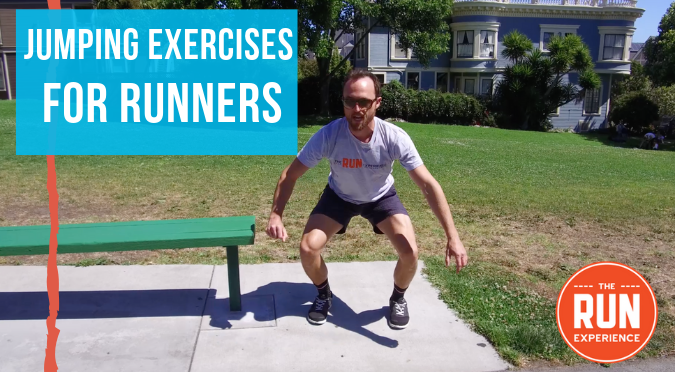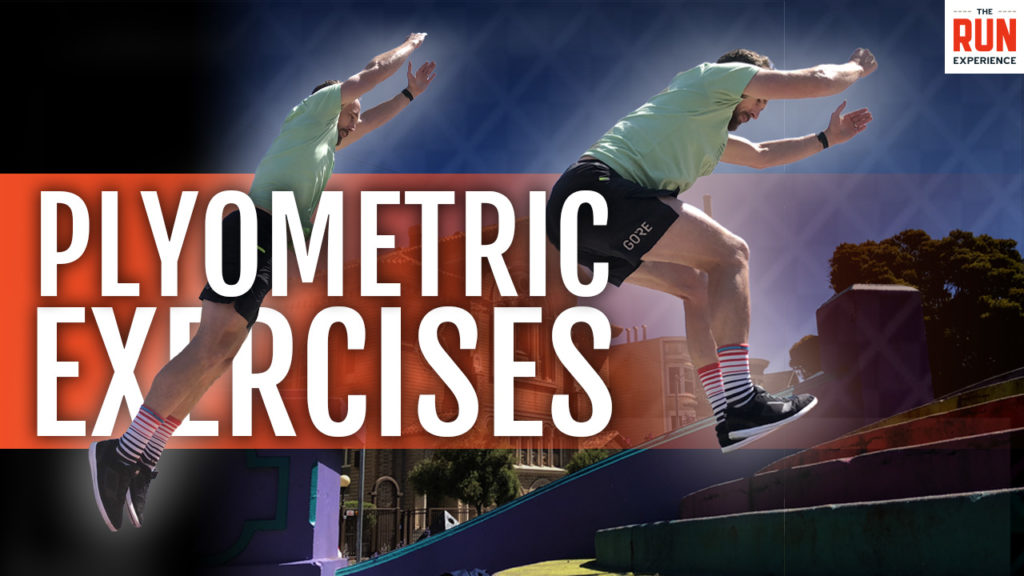Running and Jumping: 3 Best Jumping Exercises for Runners

Lots of runners skip plyometrics for the same reason they skip strength training and stretching—because it’s not running. But running and jumping go hand in hand.
Being a better jumper certainly makes you a better runner, and we have the 3 best jumping exercises to help you get there.

Here’s how I see the reluctant jumper—the pupils become little pinpricks as you contemplate that box jump. Your breath quickens as you approach, your arms pump back, and you get ready to go, only to think:
“I’m supposed to do THAT? I cannot do that.”
[Insert more pacing and uncomfortable silence]
I’ve seen this game go down a hundred times. By the drama of it, you might think it was related to:
- Lifting 300 pounds
- Running a five-minute mile
- Swimming in a wetsuit in January
But this fear is something different. It’s box jumping, and that 12-inch box might as well be 12 feet! But, it doesn’t have to be that way. You don’t think you can do it…but you can!
You just need to be shown where and how to start. That’s exactly what I do here in this video. I give you the keys to one of your most powerful, hidden talents…YOUR ability to jump.
Running and Jumping—It’s What You Do
As runners, we are born jumpers! We have springs on our feet which allow the human being to do some pretty darn amazing stuff.
Yet, most of us NEVER tap into this gear. We don’t dare to try and we justify it to ourselves by saying how “it’s…well…probably not that important anyway.”
But, runners who don’t jump don’t develop their most powerful asset–their ability to spring and explode upwards with their whole body. Hip extension is the one thing that virtually brings all athletes together, and it’s the ONE THING that I see most runners lack.
So, what are the greatest benefits of jumping exercises for runners? Let us count the ways…
Key Benefits of Jumping
- Jumping fosters muscle strength and promotes good muscle tone for both your lower and upper body.
- It burns a ton of calories–about 800 calories per hour.
- Jumping increases your bone density, which helps prevent stress fractures and osteoporosis.
- You can do it nearly anywhere–a hotel, the gym, on the trail, or at the track.
- It boosts your metabolism–during your workout and throughout the entire day.
- Jumping adds variety to your workouts and helps prevent you from hitting plateaus.
- It improves your coordination, no matter what sport or activity or participating in.
- Jumping is fun! You get to experiment with different types of jumps and challenge yourself with how far and high you can go.
Let’s get started and get on our way to the best jumping exercises that will make you a stronger, faster runner.
3 Best Jumping Exercises for Runners
1. The Squat Down Jump
This is a great place to start if you’re a runner who is new to jumping exercises and learn the mechanics of basic plyometrics. Also, if you’re a bit timid to jump onto things (like boxes), get comfortable here and gain some confidence first.
- Find a flat surface and sink down into a squat, keeping your back flat and your knees level over your toes.
- Lean forward and jump up, using your quads to power your jump and raising your hands up over your head.
- Sink right back down into another squat. Do five to seven squats.
- Rest for 30 seconds to one minute. Repeat for three to five sets.
2. The Standing Broad Jump
Instead of just jumping straight up, this time you’ll be shifting your weight forward and explosively move forward. A good analogy is thinking of how a frog jumps ahead with force.
- Sink into a squat just like you did in the first exercise.
- Jump forward with power from your quads and hamstrings.
- Softly land right back into a squat, keeping your knees and hips stable.
- Start with a small jump, and experiment with seeing how far you can go.
- Do five to six jumps in a row. Take a 30-second to one-minute break, and repeat for three to five sets, depending on how you feel.
3. The Elevated Surface Jump
Now we’re ready to cook with gas and jump onto an elevated surface. It can be a park bench, a staircase, tires, or a box in the gym–whatever works where you are! Start with someone small, maybe six inches or so.
Then, work your way towards higher surfaces. Play with different heights and see how high you can comfortably go–have fun with it!
- Sink down into a squat.
- Jump forward the same way you did in the last exercise, but this time land on the surface in front of you.
- Jump back down to your starting position
- Repeat the jump five to six times. Rest for 30 seconds to one minute in between.
- Complete three to five sets.
The All-in-One Jumping Workout for Runners
Jumping exercises, often referred to as plyometric exercises, are a valuable addition to a runner's training regimen. They can help improve explosive power, strength, agility, and running economy. Here's an all-in-one jumping workout tailored for runners:
Warm-Up (10-15 minutes)
- Easy Jog: 5-7 minutes to get the blood flowing.
- Dynamic Stretches: Leg swings (front-to-back and side-to-side), arm circles, and hip circles.
- Activation Exercises: Walking lunges and high knees.
Jump Squats (3 sets of 8-10 reps)
- Start in a squat position.
- Explode up, reaching arms overhead and fully extending your body.
- Land softly and descend back into the squat position.
Box Jumps (3 sets of 6-8 reps)
- Using a stable platform or box, stand in front of it.
- Bend into a half-squat and jump onto the box with both feet.
- Jump back down or step down carefully.
Bounding (3 sets of 50-100m)
- Think of this as exaggerated running with longer and more forceful strides.
- Focus on propelling yourself forward with each leap, aiming for both height and distance.
Skater Jumps (3 sets of 10 jumps each side)
- Start in a small squat.
- Jump sideways to the left, landing on your left leg with your right leg trailing behind.
- Jump to the right, reversing the motion.
Burpees (3 sets of 8-10 reps)
- Begin in a standing position.
- Drop into a squat position, placing your hands on the ground.
- Jump your feet back, landing in a plank position.
- Perform a push-up.
- Jump your feet back toward your hands.
- Explosively jump into the air, reaching your arms overhead.
Single-Leg Hops (3 sets of 10 jumps each leg)
- Stand on one leg.
- Jump forward, landing on the same foot.
- Aim for controlled, deliberate jumps.
Cool Down (10 minutes)
- Easy Jog or Walk: 5 minutes to bring your heart rate down gradually.
- Static Stretching: Focus on quads, hamstrings, calves, hip flexors, and glutes.
Additional Tips for Your Jumping Workout
- Landing Technique: Always ensure you're landing softly to absorb the impact and protect your joints. Think "quiet" landings.
- Rest Between Sets: Rest for 30 seconds to a minute between sets, ensuring you're recovered before starting the next exercise.
- Frequency: As this is an intense workout, it's recommended to do it 1-2 times a week with at least 48 hours of recovery between sessions.
- Strength Training Complement: Plyometric workouts pair well with a strength training regimen, enhancing overall muscular strength and power.
Remember to listen to your body—it's okay to modify or skip exercises if they don't feel right.
How Jumping Improves Your Run
So, go through these 3 different types of jumping exercises and get started right now! Add these exercises one to two times per week and you’ll almost immediately notice:
- A more powerful, efficient stride
- The ability to jump over obstacles in races or streams in a training run
- A stronger finishing kick at the end of each race or workout
- The ability to leap buildings in a single bound–just kidding!
You might not be Superman, but you’ll certainly feel more like him the next time you tackle your next run. It’s time to get running and jumping!
Ready to conquer new personal records and get in the best shape ever? Download the new TRE mobile app today!
It’s full of workouts, coaching advice, videos, and more. Want the full details? Read this post dedicated to everything you need to know related to our new mobile app.

